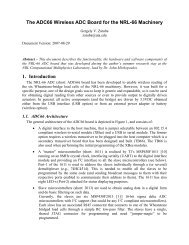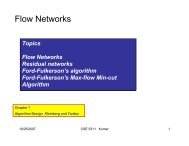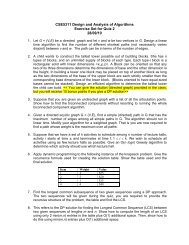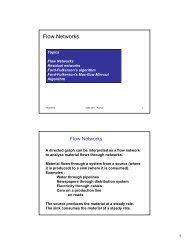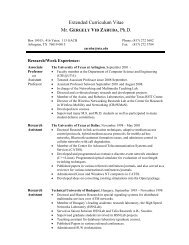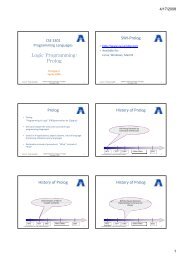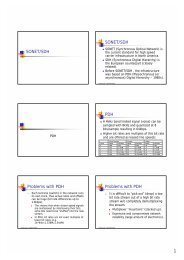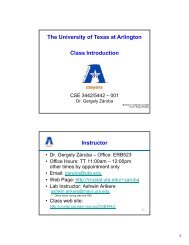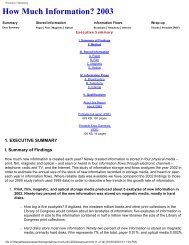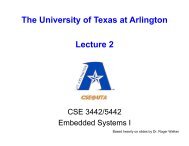You also want an ePaper? Increase the reach of your titles
YUMPU automatically turns print PDFs into web optimized ePapers that Google loves.
Wireless ATM – Routing And Real Time Delivery<br />
<strong>Reshma</strong> <strong>Bhalla</strong><br />
Masters in Computer Science , University Of Texas @ Arlington,TX<br />
reshmabhalla@hotmail.com<br />
Abstract . This paper discusses the potentials of Wireless ATM in the present Scenarios. It includes<br />
the description of the various issues in the field of Wireless ATM, particularly the rerouting issues in<br />
detail and the potential future works which need proper considerations. Wireless ATM technology is<br />
becoming a dominant one in the present days as it has the capabilities of supporting a range of services,<br />
ranging from time –sensitive, Real time to Bursty traffic. This Paper sketches a brief overview of the<br />
Wireless ATM, the issues in the Wireless ATM technology and concentrates particularly on the Routing<br />
and the Real time data Delivery.<br />
1. Introduction<br />
The need to support more demanding applications , like the multimedia, voice conversation in<br />
parallel to the normal bursty traffic , has taken the attention of many researchers . Some of the<br />
recent topics in the field of Wireless ATM are Connection rerouting schemes, Route<br />
Optimizations, Lossless Handovers, Mobile Multicasting in the Wireless ATM, Quality of<br />
service over wireless ATM, Buffering techniques for lossless Handover in Wireless ATM,<br />
develop an efficient protocol that will run on the wireless medium without much of the delay and<br />
error. Till now no standard protocol has been made by the ATM Forum or the ITU-T as they are<br />
trying to get the High speed networks work without error and with a higher speed. The Wireless<br />
networks of the ATM-type are certainly going to play a very important role in the broadband<br />
communications network of the future. [1]<br />
1.1 ATM Overview<br />
An ATM network consists of fast packet switching systems linked via point to point links to<br />
each other and to their terminal nodes. An ATM packet is a 53 byte packet with the 48 bytes of<br />
data and 5 bytes of the control information. There is a point-to-point connection setup between<br />
the two hosts before any data is exchanged between them.<br />
It is during this initial connection setup that the desired level of service between the hosts is put<br />
forth to the ATM network and if the network is able to support the desired service only then a<br />
reliable, guaranteed, point to point network is set up between the two hosts. An ATM network on<br />
a wired network has been till date guaranting all these features, but when we look at the Wireless<br />
ATM, the procedure for the initial connection setup is the same, But what happens when there is<br />
a Mobile Host and after the initial connection setup he changes the position? , How is the<br />
rerouting of the Connection taken care off smoothly? These are some of the issues which we<br />
would be exploring in this paper .<br />
Wireless ATM, as opposed to the traditional Ethernet is different in that in the Traditional<br />
Ethernet the sharing of the medium is random, whereas in the Wireless ATM the sharing of the<br />
1
medium is at the discretion of the switch .The switch requires information about the needs of the<br />
End terminals in order to allow a particular connection to setup. The switch will give access to<br />
the medium only if it finds that the new connection will not degrade the already setup<br />
connections. The finite buffers in the switches do drop the packets sometimes, but this is<br />
concealed by the ATM Adaptation layer (AAL) because of its capabilities to retransmit and<br />
reconstruct the packets. Some of the other functions of the AAL is to re-assemble the received<br />
frames and to segment the frames into cells. The different flavours of the Adaptation layer that<br />
are now popularly used are the AAL0 , AAL1 , AAL2 , AAL3/4 , AAL5. These differ in terms<br />
of the type of service which they provide/support. One of the examples which uses a<br />
combination of the AALs is a video conferencing application, where the transfer of voice uses<br />
the AAL1, the transfer of video uses the AAL2 layer and the data transfer uses the AAL5.<br />
1.2 Wireless ATM<br />
Wireless ATM is an extension to the Wired ATM, with the aided concepts of Mobility and<br />
the already existing features of reliability and the capability, to provide on demand support to<br />
many different traffic types with different quality of service aspects. Also Wireless ATM<br />
systems are typically based on cellular network layout with very small cells (micro or pico).<br />
Hence due to the small cell size, handover between the radio cells will be very frequent [3]. The<br />
mobility aspect forces a decoupling of the normal mapping of node and switch port. Instead, a<br />
wireless access point “connects” the set of wireless nodes, it services, on a single port of the<br />
ATM switch [2]. [3]<br />
Two dominant approaches can be identified for the integration of wireless ATM to support a<br />
fixed ATM network. At one extreme, wireless ATM is viewed as an overlay to the fixed<br />
infrastucture.In such an approach , mobility support is mostly implemented using separate<br />
network elements specific to the mobility. The other approach is to view Wireless ATM as an<br />
integral part of an ATM network.In this case , the ATM switches are enhanced with mobile<br />
specific features. The resulting switch can support both mobile and fixed users and no special<br />
types of switches are required to support mobility.In this case, the fixed ATM network becomes<br />
a shared switching and transmission infrastructure for both fixed and mobile users. The access<br />
point is connected to an ATM switch over an ATM UNI interface. The switch in turn is shared<br />
between fixed and mobile users. In addition to the connection control functions located with in<br />
the switch , some mobility related functions like the location management and the terminal<br />
authentication , etc, are required.For interaction with the Mobile terminal , the switch uses an<br />
enhanced version of the ATM UNI signaling protocol for connection control and handover. In<br />
addition to this, an additional protocol called as the Access Point Control Protocol (APCP) is<br />
used. The APCP allows the switch to interact with the access point duration connection set-up<br />
and handover.<br />
As the focus of this paper is on the routing issues, we shall concentrate more on that.<br />
We shall study the issues in routing in section 2 and the various rerouting schemes in the section<br />
3, with a deeper study of the two of the schemes and in section 4 the simulation results of the two<br />
schemes are discussed, followed by the conclusion.<br />
2
2. Issues in routing<br />
ATM Switch<br />
Base<br />
Station<br />
MH<br />
3<br />
ATM Switch<br />
Base<br />
Station<br />
Hand off<br />
Fig 1<br />
Basic Scenario in the Wireless ATM<br />
ATM, being a connection -oriented means of transferring the data, requires that a<br />
connection d be setup before any kind of transfers. As the mobile user moves, The ATM<br />
connection needs to be modified (or rerouted) to support seamless communication. [4]. Some of<br />
the important issues during this connection rerouting are, the new path which is selected for<br />
rerouting has to be Optimal and it should not lead to triangular routing or any kind of looping,<br />
the lossless handoff issue, which deals mainly with the reduction in the number of packets lost<br />
due to handoff, the handoff delay (the time interval between moving to the new location and start<br />
receiving ATM cells) [4]. Some of the other issues which we need to take care while developing<br />
any kind of the rerouting scheme is whether the ATM cell sequencing is maintained by a<br />
rerouting scheme or not, the rerouting scheme that can be supported by the network<br />
configuration (infrastructure or ad-hoc or both).<br />
MH
3. Connection Rerouting Schemes<br />
Some of the major connection rerouting schemes are mainly based on: (a) Connection<br />
re-establishment [5]– the new connection that is established after the mobile user has moved. (b)<br />
Connection extension [6] – extending the connection to the new location where the mobile user<br />
has moved. (c) Anchor switch routing [7] – keeping the part of the route unchanged to the<br />
switch and then modifying the path from the switch to the new location. (d) Dynamic rerouting<br />
[8]- rerouting the connection while the mobile host is on the move. (e) Hybrid schemes [9]-<br />
Combining of the two or the more routing schemes. (f) Setting paths in advance for<br />
communications in the wireless network [10].<br />
Most of the research in rerouting or handoff management involves the use of<br />
connection extension, dynamic rerouting, connection tree or hybrid schemes [4].<br />
In the connection extension mechanism a novel Homing algorithm has been<br />
proposed, in which, as the mobile user moves from its current location to a new location, the<br />
initial routing of the packets to a destination node is done through the old base station (which<br />
was also the Initial Home base station) and also slowly the current base station is updated so as<br />
to make it the Home base station of the Mobile user and there after all the cells are directly send<br />
from the new Home station to the destination and the same is applicable to the Destination Home<br />
base station. This scheme also preserves the sequence of the ATM cell without any kind of a<br />
central sequencer or without any kind of re-sequencing at the destination. The base station<br />
should have some kind of mechanism to decide upon an optimized path before the extension of<br />
the path. [4]<br />
In the dynamic rerouting scheme [8] a common switch is found between the path from<br />
the source to the old base station and the new base station, this is a cross over switch, this helps in<br />
making less changes in the new path, but also leads to some delay, in order to determine the new<br />
crossover switch (COS) and make changes in the COS for the new connection. This is one of the<br />
most popular schemes and a lot of work has been done in this. In [8] the authors have proposed a<br />
hierarchical rerouting (HRR) scheme for the handoff .In this scheme the Crossover scheme is<br />
determined in an hierarchical manner. In this the discovery of the crossover switch, one needs to<br />
have a proper understanding of the PNNI (private network to network interface) standards. The<br />
hierarchical scheme as opposed to the flat scheme decreases the handoff latency. The discovery of<br />
the crossover switch also depends a lot on the network configuration. [4]<br />
The Virtual tree based scheme [15] consists of a Root switch (RS), which is the root of<br />
the virtual tree, the other switches connected to it are branches, as in a tree structure, to these<br />
switches a base control switch is connected, which supports a collection of base stations which in<br />
turn support the mobile hosts. Each base station controller has a radio access system (RAS). In<br />
this kind of a scheme if the mobile host does a handoff from one base station to another base<br />
station with in the same radio radio access system then the procedure for the new connection is<br />
very simple as whenThe handoff is between the two RS (inter RS handoff).<br />
If the mobile user movers to another base station with in the same RAS, after the initial<br />
permissions to connect into the virtual tree, it sends a Virtual Branch number (VBN), which sets<br />
up a path between the RS and the base station and the mobile user receives all its data on this<br />
4
Virtual Branch, now if the mobile user changes to another base station all it has to send is a new<br />
Virtual branch number, as opposed to this if the mobile user moves to another RAS the<br />
connection admission control function will have to be called and all the resources with in the<br />
RAS will have to be investigated to see if the RAS can support the new users resource demands<br />
and hence the work involved is more. [4] In brief this is more like an advance path setup scheme<br />
in which the ATM connections are setup before a mobile host moves into a new location .It<br />
mainly involves the setting up of a complete tree of paths covering several neighboring cells and<br />
then the rerouting is performed by the host selecting a different branch of the tree by using a<br />
different connection number.<br />
There are routing schemes that are prediction based, in which the algorithm sets<br />
up the new path in advance, based on the moving pattern of the mobile user. Such schemes<br />
however show efficiency only if there is efficiency in the prediction [4, 12].<br />
The hybrid scheme uses the advantages of more than one scheme, by using a<br />
combination of schemes. For example, the Rearrange ATM Connection (RAC) and extend<br />
ATM connection scheme (EAC)[4, 13, 14] is based on connection rearrangement and extension,<br />
kind of a Hybrid scheme. This scheme introduces an entity called as Network Call Processor<br />
(NCP), which handles the re-routing requests. The NCP works in collaboration with the Base<br />
stations, i.e. if the NCP is experiencing load due to the already existing connections or due to the<br />
unavailability of the resources to guarantee the quality of service for the new connection, or the<br />
already queued requests, then it broadcasts a message to the base station to take care of the<br />
rerouting by means of the connection extension scheme. In this scheme the NCP broadcasts the<br />
information or its state periodically, so that the base station will know when it has to use the<br />
connection extension scheme in order to handle the recent re-routing request. In this scheme the<br />
NCP first looks at its load factor and if it is able to support a particular request, an RAC<br />
algorithm is run. As soon as the Mobile host moves into the domain of a new base station, and<br />
sends a request to the NCP, the NCP runs the RAC algorithm and divides the ATM switches into<br />
four sets, namely the YN (were there but not needed anymore), YYc (were there and still needed<br />
with change), YYn (were there and still needed with no change), NY (were not there but needed<br />
now). The NCP then fills in the information of these sets with respect to the present reroute<br />
request and then REARRANGES the routing table information for the switches which need to<br />
change and now point to the new location. There are various criteria by means of which the NCP<br />
will take decisions while forming the new route for the Mobile host; these are mainly in terms of<br />
the number of messages that can be exchanged, or the number of switches along the route. Now,<br />
if the NCP is not able to accept the request then the base station will implement the EAC<br />
algorithm to run and fulfill the request requirements. In this the current base station will request<br />
the new base station to extend the ATM connection and in return also asks for a list of all the<br />
base stations that are previously connected to the new base station. Whenever there is an<br />
extension of the connection through the base stations there is always a possibility of the looping<br />
and the triangular routing problems. A general algorithm proposed [4] takes care of that and<br />
makes the routing more efficient .In this algorithm the new base station checks if it would be<br />
able to provide the requested quality of service and also checks for any kind of loop formations<br />
and triangular routings and then runs the part of the algorithm that takes care of the looping, as<br />
soon as the looping is experienced the new base station stops forwarding the ATM cells and then<br />
sends a marker cell followed by an EXTEND-CONNECTION message, to the current base<br />
5
station and then after recovering the ATM and the marker cells, the new base station sends the<br />
LOOP-CLEARING message to the current Base station . In order to take care of the triangular<br />
routing problem the new base station sends the REQUEST-REROUTE to the neighboring base<br />
station and if the neighboring base station can provide the quality of support that is required, the<br />
neighboring base station stops forwarding the ATM cells to the new base station and then sends a<br />
marker cell and then the new base station sends an EXTEND-CONNECTION message to the<br />
current Base station and after recovering the ATM cells and the marker cells the new base<br />
station sends an REROUTE message to the current base station. But if the quality of service<br />
cannot be provided by the neighboring base station the new base station sends an EXTEND-<br />
CONNECTION to the current base station.<br />
Two schemes for Route Optimization are proposed in [12], in which a route optimization<br />
algorithm for the ATM networks based on the PNNI (Private Network-to-Network Interface,<br />
provides a solution to the Handoff management problem. The first scheme is a one-phase scheme<br />
in which the rerouting procedure is integrated into the handoff procedure. A second solution is<br />
the two-phase method, in which the fast handoff are taken care by a sub optimal routing and then<br />
optimization to this route is done The new proposed procedure for route optimization scheme is<br />
for the connection oriented networks and requires that a connection be set up between a Cross<br />
over switch (COS) and one of the ends of the connection in order to reroute a connection and to<br />
transfer the user data into the new switching from the old path, without the loss of ATM<br />
sequence.<br />
The route Optimization algorithm involves four steps in order to solve the base<br />
rerouting problem (a) to determine the crossover node (b) to establish a new connection between<br />
the new base station and the COS (c) Switch the user data from the old segment to the new one<br />
(d) and finally release the old connection between the COS and the old base station. [12] Out of<br />
these the determination of the crossover node is an important one .In this an Optimal cross over<br />
node is chosen and as much overlap as it is possible between the old and the new paths is<br />
achieved .Two aspects of the PNNI based networks that are fundamental to this procedure are:<br />
(a) every node only has summarized information regarding the topology of the network with in<br />
the peer group (nodes outside of a peer group do not have information regarding the internal<br />
structure of that peer group) and (b) connections are routed using hierarchical routing.<br />
In order to find an optimal crossover node, the nodes need to have an exact picture of the<br />
relationships at the ancestors-are-siblings level in the PNNI hierarchy, and hence three scenarios<br />
are considered by the algorithm to calculate an optimal cross over node. (a) A case in which the<br />
new base station is close (closeness in terms of the levels in the hierarchy) to the old base station<br />
when compared its distance from the far end to itself, in this case an optimal crossover node will<br />
be the ingress border node of the ancestor–are-siblings peer group. This is because of the fact<br />
that in a PNNI network, nodes have information about the members of only their group and do<br />
not have information about the nodes outside their group and thus an exact location of the nodes<br />
that are reachable from their peer group cannot be determined. (b) A case when the old base<br />
station is closer to the far-end, when compared to distance between itself and the new base<br />
station, in this there is no portion of the old connection that will remain the same for the new<br />
connection and the far end itself is considered as an optimal crossover node, and hence the new<br />
connection is established all over from the far end to the new base station. (c) A case where the<br />
new base station is closer to the far-end or the new and the old base stations are equidistant to the<br />
6
far-end station, in this situation there is no segment that would be common to both of them and<br />
hence once again the far-end station is considered as the new crossover node.<br />
After the determination of an optimal crossover node the setting of the connection between<br />
the optimal crossover node and the new base station takes place, now the identity of the optimal<br />
crossover node is obtained by examining the detailed path of the existing connection and if the<br />
process of route optimization was started by the new base station then a connection is setup<br />
between the new base station and the optimal cross over node, if this process was initiated by the<br />
old base station, then the old segment is tracked back till the optimal crossover node is reached<br />
and then a new connection is set up from that cross over node to the new base station.<br />
Let us consider a case when there are frequent handoffs, that is a mobile host<br />
changes its cells frequently, this is called the second phase route optimization, in this scheme the<br />
route optimization is done only after a couple of handoff have been done. In the two-phase<br />
scheme, the first phase determines a sub optimal route to the new connection and if there are<br />
more handoffs, a new sub optimal route is selected and then after a couple of such handoffs the<br />
route optimization routine is run. The Optimization is the second phase and consists of four steps<br />
(a) the determination of the connection segment, to reroute and the corresponding target node or<br />
the new base station is selected. (b) The determination of the crossover node and the setting up of<br />
the connection between the crossover node and the new base station. (c) Switching of the old<br />
data path to the new path. (d) Releasing the connection between the old base station and the<br />
crossover node is done.<br />
Another aspect for rerouting, which is mentioned in [12] is dynamically<br />
determining the crossover node and determination of an optimal route while setting up new<br />
connections to the new base station. This is called as the one phase dynamic Crossover switch<br />
search handoff scheme. This scheme also has the four steps of determining the crossover node,<br />
setting up the connection between the crossover node and the new base station, then directing all<br />
the data to the new base station and the releasing the old connection by some way of signaling.<br />
The process of determining the crossover node is already discussed; let us have a look at some of<br />
the aspects of switching the user data from the old to the new path and the releasing of the old<br />
connection. This procedure depends on the type of the desired handoff, if the desired handoff is<br />
of lossless, (that is there should be no loss of the cells) type and the sequence of the cells be<br />
maintained, then a different approach is taken, were in the “Tail ” signals and buffering is used to<br />
switch the user data from the old path to the new base station .Now depending on the type of the<br />
hand off, whether the handoff is soft (where in data can be send to and received from both the<br />
old and the new base stations)or hard(data cannot be send or received from the old base station)<br />
the routines are run. The soft handoff is same as the case in the two phase scheme except that in<br />
the one phase scheme the mobile node is the source node that participates in the switch over as<br />
opposed to which in a two-phase scheme the mobile node is the new base station. During the<br />
hard hand off a “Tail” signal is sent from the cross over switch to the old base station and all the<br />
cells that are buffered into the old base station are sent to the crossover switch, as soon as the<br />
crossover switch receives the buffered cells from the old base station, it immediately forwards<br />
them to the new base station and for all the subsequent cells which are buffered at the crossover<br />
switch itself, a “Tail2” signal from the old base station is awaited for, and only after the<br />
reception of the “Tail2” signal the cells that are buffered at the crossover switch are then<br />
forwarded to the new base station.<br />
7
4. Summaries and Conclusions:<br />
In this paper I have discussed the various routing schemes that are currently developed, in<br />
order to have an Optimized route in the Wireless ATM when ever there is a hand off. I have<br />
Summarized (Fig 2) the advantages and the disadvantages of two [4][12] schemes.<br />
After looking at the various schemes for rerouting in wireless ATM, I suggest that the<br />
hybrid scheme could be a good solution, taking into consideration the advantages of more than<br />
one scheme and coming up with an efficient route.<br />
Routing Scheme Advantages Disadvantages<br />
[4]<br />
RAC + EAC<br />
[12]<br />
Hierarchical routing<br />
5. Future work<br />
1. Optimal Routes<br />
2. NCP – Simple to<br />
implement<br />
3.NCP–bandwidth efficiency<br />
1.More scalable<br />
Fig 2<br />
Summary<br />
8<br />
NCP - More Processing<br />
intensive.<br />
EAC - Inefficiencies during the<br />
routing.<br />
EAC - complex base stations<br />
will be required.<br />
Processing time is more in order<br />
to calculate the crossover switch<br />
With the increasing popularity and the power of the portable computers and wireless LAN<br />
applications, particularly the multimedia being an integral component of all the evolving new<br />
applications, ATM based wireless access applications are becoming highly desirable.<br />
The most important issues in the design of wireless ATM systems are the issues to be<br />
dealt at the physical layer, the issues at the data link layer, the multiple channel access issues and<br />
of course the mobility management issues.<br />
The problem of the mobility management depends upon a number of<br />
factors, like the network configuration, the structure of the network, the demands of the<br />
applications which are to be served by the network, the quality of service requirements, the<br />
mobility pattern of the mobile user, the quality of the radio signal strength, the internetworking<br />
of the networks and so.<br />
With such a large variation in the demands from the different types of applications and the<br />
a variety of the Local area networks, Some of the possible issues which can be considered for<br />
future works are, the joining of the networks different types of routing schemes and forming an<br />
internetwork, the reduction in the processing delay while selecting an optimal route, the<br />
reduction in the handoff delay, the QoS issues in the Wireless ATM, the recovery mechanisms,<br />
in case there is a failure in the switches, base station , or the mobile users.
References<br />
[1] Benny Bing . A survey on wireless ATM technologies and standardization . Telecommunication Systems , Vol<br />
11 , 1999<br />
[2] Greet A. Awater and Jan Kruys.Wireless ATM - an overview . ACM/Baltzer Journal on Mobile Networks<br />
and Applications (MONET), Vol 1, 1996.<br />
[3] H. Mitts, H. Hansen, J. Immonen, and S. Veikkolainen. Lossless handover for wireless ATM .<br />
Mobile Networks and Applications (MONET), Vol. 1, No. 3, 1996.<br />
[4] U. Varshney.Connection rerouting schemes for wireless ATM networks.In Multimedia tools and<br />
Applications,No.15, 2001<br />
[5] K. Keeton, B. Mah, S. Seshan, R. Katz, and D. Ferrari. Providing connection-oriented network services to<br />
mobile hosts . In Proc. USENIX Symp. on Mobile and Location Independent Computing, Cambridge, MA,<br />
August 1993.<br />
[6] K.Y. Eng, M.J. Carol, M. Veeraraghavan, E. Ayanoglu, C.B. Goodworth, P. Pancha, and R.A.<br />
Valenzuela. BAHAMA: A broadband ad-hoc wireless ATM local-area network . In Proceedings of<br />
the IEEE International Conference on Communications ‘95, Seattle, WA.<br />
[7] M. Cheng, S. Rajagopolan, L.F. Chang, G.P. Pollini, and M. Barton . PCS mobility support over<br />
fixed ATM networks. IEEE Communications Mag., November 1997.<br />
[8] J. Li, R. Yates, and D. Raychaudhur . Handoff control in the PNNI hierarchy of mobile ATM<br />
networks. In Proceedings of the Hawaii International Conference on System Sciences, published<br />
by IEEE Computer Society, Los Alamitos, CA, January 1999.<br />
[9] U.Varshney. Two connection re-routing schemes for wirelessATMenvironment . In Proceedings of<br />
the IEEE International Conference on Universal Personal Communications, Vol. 2, pp. 733–737,<br />
1997.<br />
[10]S.F. Bush, S. Jagannath, R. Sanchez, J.B. Evans, V.S. Frost, G.J. Minden, and K.S. Shanmugan<br />
. A control and management network for wireless ATM systems . ACM/Baltzer Journal on<br />
Wireless Networks, September 1997.<br />
[11] G. Liu and G. Maguire, Jr..A class of motion prediction algorithms for wireless mobile<br />
computing and communications. ACM/Baltzer Journal on Mobile Networks and Applications<br />
(MONET), Vol. 1, No. 2, s1996.<br />
[12] G. Dommety, M. Veeraraghavan, and M. Singhal. Route optimization in mobile ATM networks<br />
ACM/Baltzer Journal on Mobile Networks and Applications (MONET), August 1998.<br />
[13] U. Varshney. A scheme for connection management in wireless ATM networks. In Proceedings<br />
of the First NDSU Workshop on ATM Networking, Fargo, ND, August 1996.<br />
[14] U.Varshney.Two connection re-routing schemes for wirelessATMenvironment. In Proceedings of<br />
the IEEE International Conference on Universal Personal Communications, Vol. 2, pp. 733–<br />
737, 1997.<br />
9
[15] Valerio Mocci , Yim-Fun Hu .Virtual tree-based multicast routing with a distributed numbering algorithm for<br />
WM-ATM handover. ACM/Baltzer Journal on Mobile Networks and Applications (MONE T), No.<br />
5, 2000<br />
10



